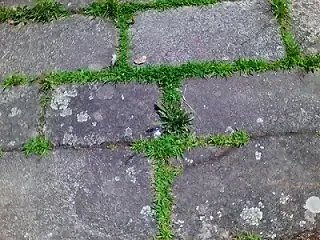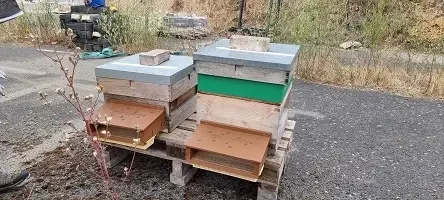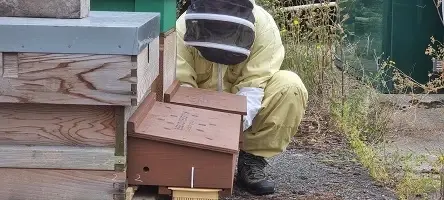An unbeelievably brilliant biodiversity project that could help mitigate the negative effects of climate change
16 February 2023
Did you know? We look at key ways in which innovation can contribute to enhancing our Customers’ standard of living and supports work in developing our assets and investments.
We always look for innovative ways in which we can protect our People, homes and Communities from the negative effects of climate change and create a sustainable future.
As part of this work, we recently collaborated with Belgian company, BeeOdiversity, on a project which collated and analysed pollen data for important biodiversity information in two of our Communities.
The trials have now come to an end, and you can find out the results below.
But first, what is biodiversity?
In short, biodiversity is the name we give to the variety of species of all life on Earth, from bacteria and plants to People. All living things exist in their own Communities and environments – or ecosystems – but we are all intertwined and depend on one another for survival.
A wide range of species in an area has numerous other benefits which may be less commonly known.
One significant advantage of species diversity is providing nature-based solutions to the negative effects of climate change and the resulting extreme weather events. Diverse ecosystems can be both fragile, yet powerful, as human activities can easily damage or disrupt them, yet the services they provide for us are invaluable and crucial to our wellbeing and future.
Global warming is a key example of a force which is disrupting the function and flow of our natural environment, and yet biodiversity could hold the key in reversing these negative effects.
Why is biodiversity so important?
Cools the planet
Biodiversity builds climate resilience through general cooling.
Trees and vegetation take carbon dioxide (CO2) out of the atmosphere to photosynthesise, which helps with cooling, however the lighter surfaces of greenery as opposed to darker surfaces consistent of tarmac and concrete significantly alter the surrounding temperature.
This is called the albedo effect which describes a surface’s ability to reflect heat from the sun. A comparison of the heat performance of dark construction materials compared to greenery can be seen in the photos below.


From this, you can see the cooling benefits of choosing to plant rich vegetation in your garden as opposed to paving it with heat-trapping concrete which could have an impact on the thermal comfort of a home.
Ever thought of having an artificial lawn instead? Don’t! Attempting to replicate this process through artificial lawns can have an adverse impact, as the plastic used for the lawn has been found to often heat to temperatures above asphalt-based materials and concrete.
Provides flood defences
Another way in which biodiversity plays a key role in climate change is reducing the levels of flooding during heavy rainfall events.
Mangroves have historically been a primary flood defence in areas of Southeast Asia, yet richer flora in the UK have also been shown to have a positive impact on reducing the flow of water into groundwater storage and regulating rates of drainage. It’s predicted that rising sea levels in the UK puts 200,000 additional homes at risk by 2030, not to mention that those homes could already be at risk because of heavier, more frequent rainfalls.
A considerable amount will be spent on flood defences in the future, with the UK already planning to spend millions of pounds on enhancing or constructing defences. And this means that some homes will likely become too expensive to save.
Natural design and biodiversity are key in cost-effective flood adaptation to cope with (let’s face it) higher incidences of flooding, and this is because the planting of greenery, hedgerows and meadows capture rainfall and delay the time in which the water is drained into the soil.
The results of our BeeOdiversity project
As we mentioned earlier, one of our projects and legacy trials was with biodiversity solution partners, BeeOdiversity.
As part of this project, we installed beehive sites in Places for People Communities – one in Northampton and one at our East Wick + Sweetwater development in London – to capture biodiversity data.


A light brush was used to extract pollen samples from the bees when they returned to the beehives, with BeeOdiversity providing us with lots of pollen data. For example, from the data extracted from the pollen at our Northampton site, we found it was from approximately 75% wild species and 68% at East Wick + Sweetwater. This data shows us the health of the local environment as wild species are vital to sustaining a resilient ecosystem.
This and other findings were reviewed to see if there were any changes in pollinating rates, which act as an indicator for any increases in biodiversity. Both trial areas showed some great results providing key indicators of plant diversity in those two Communities, in addition to information on the levels of pesticides and heavy metals in the surrounding flora.
How this relates to our Communities
This form of monitoring has useful applications for new developments by providing a robust and detailed analysis of levels of biodiversity, both pre- and post-development. The pollen analysis can also show important data such as the quality of surrounding biodiversity in the area and whether local food is being grown in a healthy environment.
As part of this project, residents in the area were provided with seeds for wild meadow flowers, to be planted in areas of the Community to help the bees and therefore increase biodiversity well after the trial.
A positive step for the future
Biodiversity and reducing pollution are both vital to ecology and the sustainable future of humanity.
This is a positive step in looking at how the natural world may be able to help us mitigate the negative effects of climate change and the risk climate change poses to our Communities.

